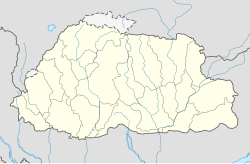Thimpu
Thimphu
|
||||||
|---|---|---|---|---|---|---|
From upper left: Tashichho Dzong, National Library of Bhutan, an aerial view of Thimphu, View of Clock Tower Square
|
||||||
| Location of Thimphu in Bhutan | ||||||
| Coordinates: 27°28′00″N 89°38′30″E / 27.46667°N 89.64167°E | ||||||
| Country |
|
|||||
| District | Thimphu District | |||||
| Gewog | Chang Gewog | |||||
| Thromde | Thimphu | |||||
| Established as capital | 1955 | |||||
| Township | 1961 | |||||
| Municipality | 2009 | |||||
| Government | ||||||
| • Druk Gyalpo | Jigme Khesar Namgyel Wangchuck | |||||
| • Thrompon | Kinlay Dorjee | |||||
| Area | ||||||
| • Total | 10 sq mi (26 km2) | |||||
| Elevation | 7,656 ft (2,320 m) | |||||
| Population (2015) | ||||||
| • Total | 104,000 | |||||
| • Density | 7,850/sq mi (3,032/km2) | |||||
| Time zone | BTT (UTC+6) | |||||
| Area code(s) | +975-2 | |||||
| Climate | Cwb | |||||
| Website | thimphucity.bt | |||||
Thimphu (/tɪmˈpuː/; Dzongkha: ཐིམ་ཕུ [tʰimpʰu]; formerly spelled as Thimbu), is the capital and largest city of the Kingdom of Bhutan. It is situated in the western central part of Bhutan and the surrounding valley is one of Bhutan's dzongkhags, the Thimphu District. The ancient capital city of Punakha was replaced by Thimphu when it was established as capital in 1955, and in 1961 Thimphu was declared as the capital of the Kingdom of Bhutan by His Majesty The 3rd Druk Gyalpo Jigme Dorji Wangchuck.
The city is spread out laterally in a north-south direction on the west bank of the valley formed by the Raidāk River, which is known as the Wang Chuu or Thimphu Chuu in Bhutan. Thimphu is the third highest capital in the world by altitude and is spread over an altitudinal range between 2,248 metres (7,375 feet) and 2,648 metres (8,688 feet). Unusually for a capital city, Thimphu is not served by an airport, but relies on the Paro Airport connected by road some 54 kilometres (34 miles) away.
Thimphu, as the political and economic center of Bhutan, has a dominant agricultural and livestock base, which contributes to 45% of the country's GNP.Tourism, though a contributor to the economy, is strictly regulated, maintaining a balance between the traditional, development and modernization. Thimphu contains most of the important political buildings in Bhutan, including the National Assembly of the newly formed parliamentary democracy and Dechencholing Palace, the official residence of the King, located to the north of the city. As a metropolis and capital city, Thimphu is coordinated by the "Thimphu Structure Plan", an Urban Development Plan which evolved in 1998 with the objective of protecting the fragile ecology of the valley. This development is ongoing with financial assistance from the World Bank and Asian Development Bank.
...
Wikipedia





